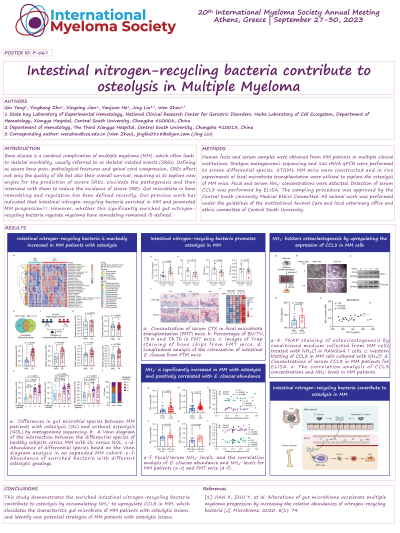Imaging and Management of Myeloma Bone Disease
Poster Session 1
P-067: Intestinal nitrogen-recycling bacteria contribute to osteolysis in Multiple Myeloma
Wednesday, September 27, 2023
1:30 PM - 2:30 PM EEST


Wen Zhou, PhD
Xiangya Road110# Changsha, Hunan Province, China
Cancer Research Institute, Xiangya School of Medicine, Central South University, Hunan, China (People's Republic)
Introduction: Gut microbiota in bone remodeling and regulation has been defined recently. Our previous work has demonstrated that intestinal nitrogen-recycling bacteria enriched in multiple myeloma (MM) and promoted MM progression. However, whether this significantly enriched gut nitrogen-recycling bacteria regulate myeloma bone remodeling remained ill-defined.
Methods: Shotgun metagenomic sequencing and 16s rRNA qPCR were utilized to screen differential species. Fecal microbiota and single bacteria transplantation were conducted to confirm osteolysis. Further experiments were performed to explore the mechanisms. During the project, the sampling procedure was approved by the Central South University (CSU) Medical Ethics Committee, and animal work was performed under the guidelines of the Institutional Animal Care and local veterinary office and ethics committee of CSU.
Results: Intestinal nitrogen-recycling bacteria is markedly increased in MM patients with osteolysis
To explore the differential bacteria of MM patients with osteolysis, shotgun metagenomic sequencing was performed and demonstrated the domination of pathological bacteria and the reduced probiotics. Especially, the abundance of E. cloacae was significantly increased, as well as a significant correlation between the severity of osteolysis was defined.
Intestinal nitrogen-recycling bacteria promote osteolysis in MM
To further assess the effect of enriched bacteria on osteolysis, fecal microbiota transplantation from MM patients with osteolysis showed more severe osteolysis in MM mice, demonstrating lower BV/TV, Tb.N, and Tb.Th of micro-CT, and higher concentrations of CTX-1 and PINP. Additionally, longitudinal analysis of the colonization demonstrated the gradual domination of E. cloacae. Furthermore, transplantation with E. cloacae confirmed the function of osteolysis in MM mice.
NH4+ produced by E. cloacae bolsters MM osteoclastogenesis
Finally, to explore the functional mechanisms, a concentration of NH4+ was detected and showed a significant increase in MM with osteolysis and a positive correlation withE. cloacae. Meanwhile, analysis of clinical characteristics demonstrated a positive correlation between the concentration of NH4+ and osteolysis in MM patients. Furthermore, NH4+ was confirmed to promote osteolysis in MM mice, as well as accelerate osteoclastogenesis in vitro with an increased expression of CCL3 detected by WB in MM cells and ELISA in MM mice. Additionally, the higher expression deaminase gene dcd was detected and then a strain of deleted dcd of E. cloacae was testified to alleviate osteolysis in MM mice.
Conclusions: Altogether, our present findings demonstrate that enriched intestinal nitrogen-recycling bacteria contribute to osteolysis by interacting with host metabolism, which reports on the characteristic gut microbiome and offers a new potential therapeutic strategy for the intervention of MM with osteolysis.
Methods: Shotgun metagenomic sequencing and 16s rRNA qPCR were utilized to screen differential species. Fecal microbiota and single bacteria transplantation were conducted to confirm osteolysis. Further experiments were performed to explore the mechanisms. During the project, the sampling procedure was approved by the Central South University (CSU) Medical Ethics Committee, and animal work was performed under the guidelines of the Institutional Animal Care and local veterinary office and ethics committee of CSU.
Results: Intestinal nitrogen-recycling bacteria is markedly increased in MM patients with osteolysis
To explore the differential bacteria of MM patients with osteolysis, shotgun metagenomic sequencing was performed and demonstrated the domination of pathological bacteria and the reduced probiotics. Especially, the abundance of E. cloacae was significantly increased, as well as a significant correlation between the severity of osteolysis was defined.
Intestinal nitrogen-recycling bacteria promote osteolysis in MM
To further assess the effect of enriched bacteria on osteolysis, fecal microbiota transplantation from MM patients with osteolysis showed more severe osteolysis in MM mice, demonstrating lower BV/TV, Tb.N, and Tb.Th of micro-CT, and higher concentrations of CTX-1 and PINP. Additionally, longitudinal analysis of the colonization demonstrated the gradual domination of E. cloacae. Furthermore, transplantation with E. cloacae confirmed the function of osteolysis in MM mice.
NH4+ produced by E. cloacae bolsters MM osteoclastogenesis
Finally, to explore the functional mechanisms, a concentration of NH4+ was detected and showed a significant increase in MM with osteolysis and a positive correlation withE. cloacae. Meanwhile, analysis of clinical characteristics demonstrated a positive correlation between the concentration of NH4+ and osteolysis in MM patients. Furthermore, NH4+ was confirmed to promote osteolysis in MM mice, as well as accelerate osteoclastogenesis in vitro with an increased expression of CCL3 detected by WB in MM cells and ELISA in MM mice. Additionally, the higher expression deaminase gene dcd was detected and then a strain of deleted dcd of E. cloacae was testified to alleviate osteolysis in MM mice.
Conclusions: Altogether, our present findings demonstrate that enriched intestinal nitrogen-recycling bacteria contribute to osteolysis by interacting with host metabolism, which reports on the characteristic gut microbiome and offers a new potential therapeutic strategy for the intervention of MM with osteolysis.
